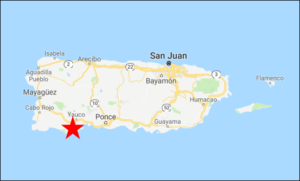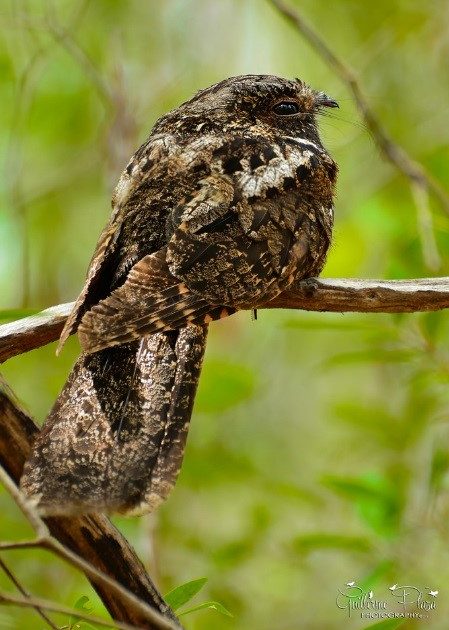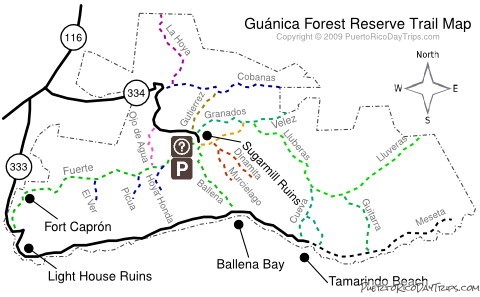Guánica State Forest, Puerto Rico

Guánica State Forest preserves the largest intact tract of dry deciduous forest on Puerto Rico. It is best known for the rediscovery of the Puerto Rican Nightjar, which was thought to be extinct but still thrives here, and can be seen or at least heard nightly throughout much of the year. Other notable endemics that can usually be found on visits to Guánica include Puerto Rican Lizard-Cuckoo, Puerto Rican Screech-Owl, Puerto Rican Mango, Puerto Rican Tody, Puerto Rican Vireo, and Adelaide’s Warbler.
Orientation
Directions
Guánica is one hour and 40 minutes’ drive (150 km) southwest of San Juan, 30 minutes (40 km) west of Ponce, and 35 minutes (45 km) southeast of Mayagüez.
From Ponce. Begin westbound on PR-2 and after about 30 km exit onto PR-116 toward the town of Guánica. The side-roads to the two entrances to Guánica State Forest are approximately 3.6 km (PR-334) and 3.9 km (PR-333) from the start of PR-116.
Turning east onto PR-334, you will pass through the neighborhood María Antonia, and arrive at the main entrance gate to the state forest after approximately 2.5 km.
Turning south onto PR-333, you will pass beside the town of Guánica, and enter the state forest state forest after approximately 2.5 km.
From Mayagüez. Begin southbound on PR-2. After approximately 40 km, exit onto PR-116, then continue as above.
Birdfinding
There are two roads into the state forest: the interior road, PR-334, which leads to the headquarters and most of the trails, and the coastal road, PR-333.
PR-334. Just north of the town of Guánica on PR-116, take PR-334 east into the neighborhood of Maria Antonia, and follow it to the state forest.
At night, to search for Puerto Rican Nightjar and Puerto Rican Owl, park beside the gated entrance and walk the road into the state forest. One of the best areas to search begins about 500m up the road, where there is a series of two hairpin turns and a third tight bend with a trail junction, providing opportunities to zero in on calling birds without leaving the road. (One spot where the nightjar has been found is at the second hairpin turn: N17°58’55.0”, W66°52’44.9”.) The trail is actually a dirt road, the Camino Las Cobanas, which often has many nightjars calling along it.
The next area that provides similar opportunities for triangulation is near the forest headquarters, where multiple roads and trails converge. This is a much longer walk, about 3 km from the entrance gate, which is fine for the exercise, but may prove too time-consuming for a late night excursion.

Puerto Rican Nightjar at Guánica. © Guillermo J. Plaza

PR-333. To search for Puerto Rican Nightjar, there are several spots to check: Km Post 2.9, Km Post 3.5, Km Post 5.2. This seaside road is often windy—and when these conditions prevail, it is best to search inland as much as possible. One place along the road where it is possible to search inland is the Ballena Trail, where it is about a 2 km hike uphill to the forest headquarters.
Guánica Town. Puerto Rican Nightjar can often be found at the edges of the town itself, perching on utility lines and hawking insects drawn to the street lights. In particular, look near the intersection of PR-333 and Calle 13 de Marzo—this is the back road that connects the main part of town directly to the neighborhood María Antonia and PR-334. There are some isolated patches of forest near street lights at both ends of this segment, and the nightjar can often be found in these areas.
Playa Santa. A nearby area that supports both the nightjar and the screech-owl, and may be worthwhile checking if the birds at the state forest are not cooperating. Head west out of the town of Guánica on PR-116. 200 m past the bridge over Río Loco, take the first exit onto PR-325.
This road quickly arrives at the adjacent town of Ensenada. To remain on PR-325, turn left as you reach Ensenada. PR-325 skirts the town’s eastern edge, then bends right (west), passes beside a small bay, skirts the town’s southern edge, then veers to the south toward Playa Santa.
About 400 m before reaching Playa Santa, a dirt road on the left (south) heads into an area that can yield both Puerto Rican Nightjar and Screech-Owl.
Daytime. Guánica State Forest supports most of Puerto Rico’s endemics and other species of interest, including: Scaly-naped Pigeon, Ruddy Quail-Dove, Mangrove Cuckoo, Puerto Rican Lizard-Cuckoo, Puerto Rican Mango, Puerto Rican Emerald, Puerto Rican Tody, Puerto Rican Woodpecker, Caribbean Elaenia, Puerto Rican Pewee, Puerto Rican Flycatcher, Puerto Rican Vireo, Black-whiskered Vireo, Eastern Red-legged Thrush, Pearly-eyed Thrasher, Puerto Rican Euphonia, Venezuelan Troupial, Puerto Rican Oriole, Adelaide’s Warbler, Puerto Rican Spindalis, and Puerto Rican Bullfinch.
Services
Accommodations
Mary Lee’s by the Sea is uniquely convenient and suitable for the typical birdwatching visitor to Guánica, as it is inside the state forest—to be more precise, it is in the neighborhood of Punta Jacinto, a beach community that is on a privately owned tract surrounded by the state forest and the ocean. Mary Lee offers a selection of apartments and cottages, all with kitchens, at affordable rates: 1-787-821-3600.
A more expensive option in the immediate vicinity is the Copamarina Beach Resort, also in Punta Jacinto: 1-787-821-0505.
A third seaside option just west of town is the Parador Guánica 1929: 1-787-821-0099
Food
There are several restaurants and grocery stores in the town of Guánica.
Notes
…
